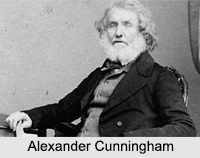 Alexander Cunningham is known as the father of the Archaeological Survey of India who was a British army engineer with the Bengal Engineer Group. He later took an interest in the history and archaeology of India. He was also an English archaeologist, army engineer, Scottish classical scholar and critic. He wrote numerous books and monographs and made extensive collections of artefacts. He was awarded with the CSI on 20th May 1870 and CIE in 1878.
Alexander Cunningham is known as the father of the Archaeological Survey of India who was a British army engineer with the Bengal Engineer Group. He later took an interest in the history and archaeology of India. He was also an English archaeologist, army engineer, Scottish classical scholar and critic. He wrote numerous books and monographs and made extensive collections of artefacts. He was awarded with the CSI on 20th May 1870 and CIE in 1878.
Early Life of Alexander Cunningham
Alexander Cunningham was born on 23rd January in the year 1814 in Ayrshire in London to the Scottish poet Allan Cunningham who was a native of Dumfrieshire. Along with his older brother, Joseph, he received his early education at Christ`s Hospital, London. At a tender age of 19 years he joined the Bengal Engineers and spent the next 28 years of his life in the service of the British Government of the Indian subcontinent. After a distinguished career he retired as the major general in 1861.
Career of Alexander Cunningham
In 1841 Cunningham was made executive engineer to the king of Oudh. Then he was posted at Nowgong in central India before he saw act at the "Battle of Punniar" in December 1843. He became engineer at Gwalior and was accountable for constructing an arched stone bridge over the Morar River. In 1845 he was called to serve in Punjab and helped construct two bridges of boats across the Beas River prior to the Battle of Sobraon. His early work Essay on the Aryan Order of Architecture arose from his trips to the temples in Kashmir and his travels in Ladakh. He was also there at the battles of Chillianwala and Gujarat in 1848. In 1851, he surveyed the Buddhist monuments of Central India along with Lieutenant Maisey, and wrote an explanation of these. He was appointed Colonel of the Royal Engineers in 1860. He retired on 30 June 1861, having attained the rank of Major General.
Cunningham had taken an intense interest in antiquities early in his career. In 1834, he wrote to the Journal of the Asiatic Society of Bengal, an appendix to James Prinsep`s article on the relics in the Manikyala Tope. He had conducted excavations at Sarnath in 1837 along with Colonel F.C. Maisey and made watchful drawings of the sculptures. In 1842, he excavated at Sankissa and at Sanchi in 1851. In 1854 he published "The Bhilsa Topes", an attempt to set up the history of Buddhism based on architectural confirmation. After his department was abolished in 1865, Cunningham returned to England and wrote the first part of his Ancient Geography of India (1871), covering the Buddhist period. In 1870, Lord Mayo re-established the Archaeological Survey of India, with Cunningham as it"s director-general from 1st January 1871. Then he returned to India and produced 24 reports, 13 as author and the rest under his management. Other major works included the first volume of "Corpus inscriptionum Indicarum" (1877) which included copies of the edicts of Ashoka, the Stupa of Bharhut (1879) and the Book of Indian Eras (1883) which allowed the dating of Indian antiquities. He retired from the Archaeological Survey on 30th September 1885 and returned to London to carry on his research and writing. In 1887, he was made a Knight Commander of the Order of the Indian Empire.
Personal Life of Alexander Cunningham
Alexander Cunningham has two brothers, Francis and Joseph who became well known for their work in British India. Then he married Alicia Maria Whish, daughter of Martin Whish, B.C.S., on 30th March 1840. They had two sons, Lieutenant-Colonel Allan J. C. Cunningham of the Bengal and Royal Engineers and Sir Alexander F. D. Cunningham of the Indian Civil Service.



















